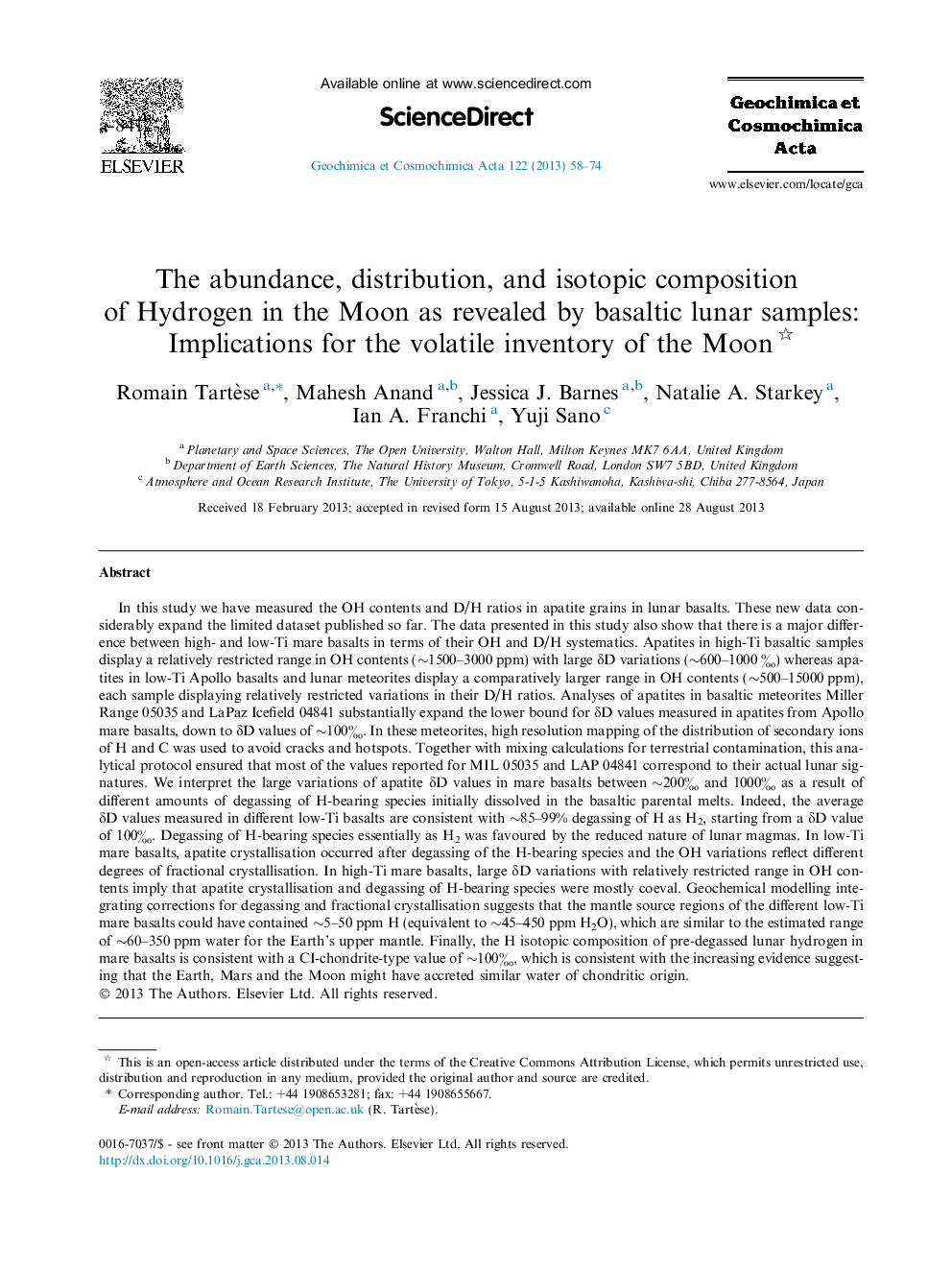| کد مقاله | کد نشریه | سال انتشار | مقاله انگلیسی | نسخه تمام متن |
|---|---|---|---|---|
| 6438797 | 1638035 | 2013 | 17 صفحه PDF | دانلود رایگان |
عنوان انگلیسی مقاله ISI
The abundance, distribution, and isotopic composition of Hydrogen in the Moon as revealed by basaltic lunar samples: Implications for the volatile inventory of the Moon
ترجمه فارسی عنوان
فراوانی، توزیع و ترکیب ایزوتوپ هیدروژن در ماه به عنوان نمونه های بازالتیک ماه نشان داده شده است: پیامدهای موجودی ماه
دانلود مقاله + سفارش ترجمه
دانلود مقاله ISI انگلیسی
رایگان برای ایرانیان
موضوعات مرتبط
مهندسی و علوم پایه
علوم زمین و سیارات
ژئوشیمی و پترولوژی
چکیده انگلیسی
In this study we have measured the OH contents and D/H ratios in apatite grains in lunar basalts. These new data considerably expand the limited dataset published so far. The data presented in this study also show that there is a major difference between high- and low-Ti mare basalts in terms of their OH and D/H systematics. Apatites in high-Ti basaltic samples display a relatively restricted range in OH contents (â¼1500-3000 ppm) with large δD variations (â¼600-1000 â°) whereas apatites in low-Ti Apollo basalts and lunar meteorites display a comparatively larger range in OH contents (â¼500-15000 ppm), each sample displaying relatively restricted variations in their D/H ratios. Analyses of apatites in basaltic meteorites Miller Range 05035 and LaPaz Icefield 04841 substantially expand the lower bound for δD values measured in apatites from Apollo mare basalts, down to δD values of â¼100â°. In these meteorites, high resolution mapping of the distribution of secondary ions of H and C was used to avoid cracks and hotspots. Together with mixing calculations for terrestrial contamination, this analytical protocol ensured that most of the values reported for MIL 05035 and LAP 04841 correspond to their actual lunar signatures. We interpret the large variations of apatite δD values in mare basalts between â¼200â° and 1000â° as a result of different amounts of degassing of H-bearing species initially dissolved in the basaltic parental melts. Indeed, the average δD values measured in different low-Ti basalts are consistent with â¼85-99% degassing of H as H2, starting from a δD value of 100â°. Degassing of H-bearing species essentially as H2 was favoured by the reduced nature of lunar magmas. In low-Ti mare basalts, apatite crystallisation occurred after degassing of the H-bearing species and the OH variations reflect different degrees of fractional crystallisation. In high-Ti mare basalts, large δD variations with relatively restricted range in OH contents imply that apatite crystallisation and degassing of H-bearing species were mostly coeval. Geochemical modelling integrating corrections for degassing and fractional crystallisation suggests that the mantle source regions of the different low-Ti mare basalts could have contained â¼5-50 ppm H (equivalent to â¼45-450 ppm H2O), which are similar to the estimated range of â¼60-350 ppm water for the Earth's upper mantle. Finally, the H isotopic composition of pre-degassed lunar hydrogen in mare basalts is consistent with a CI-chondrite-type value of â¼100â°, which is consistent with the increasing evidence suggesting that the Earth, Mars and the Moon might have accreted similar water of chondritic origin.
ناشر
Database: Elsevier - ScienceDirect (ساینس دایرکت)
Journal: Geochimica et Cosmochimica Acta - Volume 122, 1 December 2013, Pages 58-74
Journal: Geochimica et Cosmochimica Acta - Volume 122, 1 December 2013, Pages 58-74
نویسندگان
Romain Tartèse, Mahesh Anand, Jessica J. Barnes, Natalie A. Starkey, Ian A. Franchi, Yuji Sano,
